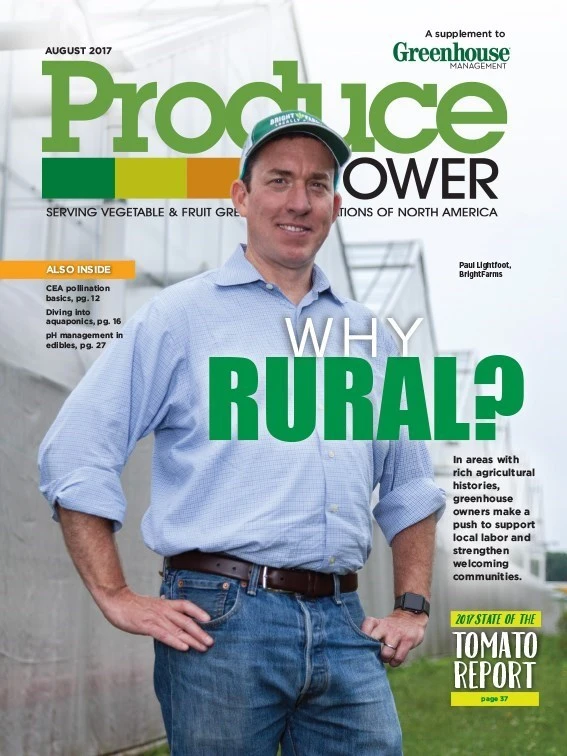
There may be no such thing as a perfect tomato, but due to research by Amy Bowen and Dave Liscombe at the Vineland Research and Innovation Centre, growers are one step closer to producing great ones.
In 2012, the Ontario Greenhouse Vegetable Growers put out a list of research priorities, and one of those priorities was to improve or differentiate flavor in tomatoes. The focus was on tomatoes on the vine, the ones consumers can buy in clusters, Liscombe says.
The team received a grant for the project from Agriculture and Agri-Food Canada and got started in the spring of 2013. The goal was to discover what consumers wanted in a tomato, and provide growers with tomatoes that have the right mix of naturally occurring chemical profile to grow.


Finding a tastier tomato
“What we want to do is understand what is it that makes one tomato more flavorful than another tomato for the consumer?” Bowen, who headed the flavor side of the research, says. “Then this information is being connected with our biochemistry group, which is where Dave Liscombe comes into play. He’s looking at the biochemistry of the tomatoes and how their chemistry relates to different flavors that are perceived by the consumer.”
To discover what consumers were looking for, Bowen and her team including Vineland's sensory panel of 15 people (all of whom had no ties to the food industry and were selected based on their ability to describe and differentiate different horticultural products) initiated a study.
“They created a lexicon of terminology that we could use to basically differentiate one tomato from another,” she says.
The panel came up with 20 different attributes that could be used to distinguish one tomato from another, such as sweetness, acidity, juiciness and others. They then took 56 varieties of tomatoes and decided which were similar and different based on those attributes.
The researchers could then select a diverse variety of tomatoes to take to consumers to test which varieties they liked better.
“Now when we go to consumers we’re looking for people that would be representative of the population that are going to be purchasing our product,” Bowen says. “We can use that to create what we call the preference map, which identifies different segments of consumers based on their preferences for the product, and also gives us the sensory attributes that are driving preference for the product.”

Top attributes
The consumers showed texture is incredibly important when it comes to tomatoes, and if the flavor is enjoyable but the texture is off, consumers will not favor it.
“Anyone who’s shopped for tomatoes in the grocery store [knows that] people tend to feel them, pick them up and squeeze them,” Liscombe says. “This is the tricky thing about tomatoes and any other produce that we need to grow in mass quantities to feed everyone.”
After texture, specific flavor factors such as sweetness and acidity were also important.
“What we found, in general, was that if it was too juicy and soft, they didn’t like it,” Bowen says. “If it was too firm with a meaty or grainy texture they didn’t like it. It had to be a strike zone somewhere in between those two.”
That information was then sent over to Liscombe and his team in order to understand what the chemical makeup looked like for the favorable tomatoes. One way the team did that was by analyzing the aroma of the tomato.
“We basically measure all these chemicals in all the tomatoes that were tasted and then look for correlations between the levels of certain chemicals and how much people liked them,” Liscombe says. “If all the tomatoes that are very much liked by consumers had very high levels of certain aroma chemicals, we conclude that they’re important in liking.”
Only about 10 percent of a tomato’s volatile chemicals that make up its aroma influences a consumer’s perception of flavor, Liscombe says, but they can be manipulated to create a better taste.
Liscombe also says it’s important to not only have good flavor and taste for consumers, but also good production traits that growers are looking for, such as disease resistance.
“The main goal here is to develop varieties that the greenhouse growers will be able to grow,” he says. “They’re not really going to be responsible for figuring out which ones are liked or disliked by consumers. That’s really what we’re going for, essentially developing varieties in the seeds for those varieties to sell to the growers.”

Explore the August 2017 Issue
Check out more from this issue and find your next story to read.
Latest from Produce Grower
- WUR extends Gerben Messelink’s professorship in biological pest control in partnership with Biobest and Interpolis
- Closing the loop
- The Growth Industry Episode 8: From NFL guard to expert gardener with Chuck Hutchison
- Raise a glass (bottle)
- From farm kid to Ph.D.
- Do consumers trust produce growers?
- The modern grocery shopper
- Beyond a burst of optimism





